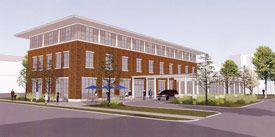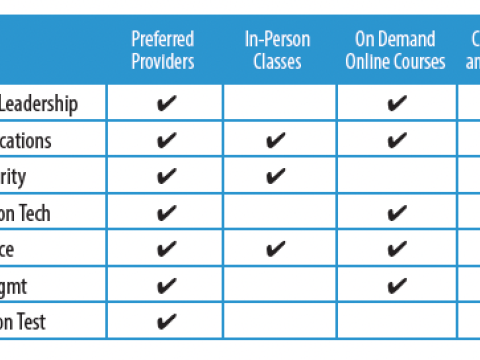Higher Education for Wounded Warriors Exploits New Technologies
Wounded veterans aspiring to receive a college education can earn diplomas from a wide selection of disciplines at a uniquely conceived center that will offer the aid of state-of-the-art assisted and adaptive devices tailored specifically to meet their needs, irrespective of their disabilities. The facility at the University of Illinois at Urbana-Champaign employs a range of advanced technologies to enable an environment for severely wounded veterans, along with any needed caregivers, to pursue educational goals that otherwise might be viewed as inaccessible.
It is not enough to send the nation’s young men and women off to war with the most advanced technology in weaponry money can buy. The United States owes it to veterans to care for them when they return home, especially when wounded, broken and suffering, says Tanya Gallagher, dean of the University of Illinois at Urbana-Champaign College of Applied Health Sciences and visionary behind the creation of the Chez Family Foundation Center for Wounded Veterans in Higher Education.
“We have had a long history of integration for research and education and service, and that’s one reason that I think we’ve maintained our national leadership in providing services to individuals with disabilities,” Gallagher says of the university. The $14 million center, scheduled to open in 2015, will feature state-of-the art residential facilities for the most severely wounded student-veterans in addition to academics, counseling, family services and health and life skills services.
Incredible improvements in medicine, both on and off the battlefield, mean more troops today survive their wounds than ever before. More than 52,000 U.S. service members have been wounded in action in Afghanistan, Iraq and other contingency areas since combat missions began in 2001, according to the Defense Department’s tabulation of casualties.
The nation has an obligation to keep pace with the medical advances, Gallagher says, and must up the ante when it comes to providing revolutionary societal needs such as health care, education and employment. “When we began to learn more about individuals who had been injured in these most recent conflicts, the severity of those injuries, and because of the types of devices that are being used and the wonderful medical care that they are receiving, survival is at unheard of levels compared to previous conflicts,” she declares. “So this has resulted in veterans with very severe disabilities who deserve a positive future. That is what we are committed to as a national leader in disability. We began to learn more about what we would need to do to adequately serve those veterans and realized very early on we could not simply integrate them into our campus without dealing with their unique needs.”
In keeping with the university’s tradition as pioneers, Gallagher says, the center and university are prepared to be innovators in the development of technologies to provide assistance. The center will feature state-of-the-art adaptive technologies, from radio frequency identification (RFID) technology that will open doors and summon elevators to wireless pagers that will connect student-residents to around-the-clock help.
On-campus suites for up to 12 veterans with severe disabilities include remote-controlled SureHands ceiling lift systems to give them mobility to all areas of their rooms, including bedrooms, bathrooms and shower areas. Lowered dining hall counter heights create an inviting, friendly environment, and students will be able to use adapted kitchens to learn to cook.
Services for student-veterans suffering from traumatic brain injury and post-traumatic stress disorder (PTSD) also will be a center focus. “We are reaching out to the most severely injured individuals because of our expertise,” Gallagher says. “The more we learn about assisted devices for individuals with brain injury, the more we will be able to continue to help other populations, like those who might be facing some cognitive challenges due to age.”
The research coming out of the center could be used in the future to treat others who suffer similar types of injuries or ailments, says Nick Osborne, the center’s interim director. “The level of research that is also going to be coming out of this center, I believe, is going to create all sorts of breakthroughs and opportunities for other populations.”
Residential services staff will provide interview, employment, coordination and supervision training for residential and nonresidential center veterans who use personal assistants, ensuring the students hone the skill set so that they might eventually reduce their reliance on family members to perform these tasks.
The center will provide prosthetics, orthotics, seating/mobility and physical, occupational, speech-language-hearing rehabilitative services, in addition to on-site telemedicine and telerehabilitation services to support veterans’ effective transitions to the Urbana-Champaign community of rehabilitation and medical services. The University of Illinois at Urbana-Champaign is the only institution of higher learning in the United States where the most severely wounded student-veterans, such as those needing assistance with activities of daily living such as showering or dressing, will have residential accommodations on campus. Any veteran with a documented disability can apply, and veterans can use benefits afforded them through the GI Bill.
Had Garrett Anderson been wounded in the Vietnam War instead of Iraq in 2005, he would have died on the battlefield from the command-detonated roadside bomb that blew his vehicle’s engine and severed his right arm, he posits. But modern medicine saved his life, and he now attends the University of Illinois at Urbana-Champaign to earn a master’s degree in social work.
“When I was laying in the bed at Walter Reed and I looked down at my arm, I had 30 seconds of pity for myself. Then I’m like, ‘I’m not going to let this injury make me a different person. I’m not going to let this injury define who I am. I’m going to define my injury.’ And that’s what the center’s going to do. It’s going to let these soldiers define their injuries and become who they want to be,” Anderson says. He supplied recommendations to staff on services he thought should be provided to student-veterans at the Center for Wounded Veterans in Higher Education. As a sufferer of PTSD, the 37-year-old former sergeant recommended the center incorporate a place for veterans to go to decompress. “It’s easy to get overwhelmed, and we needed a place where we can go and feel safe.”
Student-veterans will benefit from concentration in core areas such as career and employment development, academic services, health and rehabilitative services, and family services, Osborne says.
“What we’re finding with veterans is, as a whole, they’re nontraditional students, they have had unique life experiences, and they’re coming to higher education very differently from what we see among our traditional students. … They are arriving on college campuses, and they’re really sort of this unique population that has a tendency to isolate,” says Osborne, a former U.S. Coast Guard officer who served in Iraq. “What we want to do as an institution of higher learning is to make sure that we have the resources and programs in place that are going to make the transition from the military to higher education smooth for them, and it’s going to give them the resources they need to stay enrolled and ultimately graduate.”
The University of Illinois at Urbana-Champaign is a major research university, offering a number of majors in the STEM fields of science, technology, engineering and math. However, it too has a large liberal-arts program, law school and veterinary medicine.
“We will be recruiting from our own campus researchers across the sciences to help us build state-of-the-art assisted devices and adaptive devices,” Gallagher says. “But we also think that the more we move in this direction, it will become the place as a national resource for individuals who are interested in working with us.”





Comments